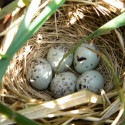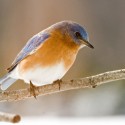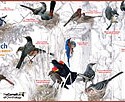 Photo ©
Keith Williams
Photo ©
Keith Williams

Lessons from the Field
Learning a new skill can be daunting, but it often helps to learn from the experiences of others. John Bigham, Jr. of New Paris, Ohio, recently shared with us some words of wisdom he’s picked up since joining the project in 2011. John monitored 24 nests this year, representing 13 different species–3 of them for the first time. He spoke with us about some lessons learned along the way in the spirit of sharing the benefits of his experience with others. We hope that it encourages newbies to get out in the field next year and collect more and better data than ever before.
- Avoid checking nests too close to the fledging date. Checking nests that are within 2-3 days of fledging puts nestlings at risk of leaving the nest prematurely. Always check from a distance using binoculars when chicks get close to fledging (i.e., they’re fully-feathered and alert). This is particularly true for open-cup nesters.
- Assess possible reasons for nest failure, and make any necessary adjustments. John reports that he definitely notices a difference in the successfulness of nests that he is able to meander around compared to those that must be checked on a dead-end path. If nests can only be approached using a dead-end trail, it might be best to observe only from a distance or not monitor that nest at all. He is also careful to watch for any nest predators (e.g., jays, crows, cats) that might be around to avoid leading them to nests.
- Just let go. Despite our best intentions, nests sometimes fail for reasons that are out of our control. Whether it’s because of drought, storms, or just bad nest positioning, John encourages others to just let go of what we can’t control and accept this as part of a nest monitor’s job.
- You can’t find what you’re not looking for. While John also monitors nest boxes, it’s the open cup nests which he prefers to watch. But how does one find the nests of birds like American Goldfinches, Red-winged Blackbirds, Brown Thrashers, and others? John’s advice is to target specific birds in the habitats that they prefer, and cue in on vegetation structures that might attract those species. For example, that low shrub in an open field might contain a goldfinch nest. That thorny rose bush near a pond is likely home to a Gray Catbird. By learning about habitat preferences, and knowing a bit about each species’ behavior, you can find many more open cup nests than you think!
Nest monitoring not only contributes to scientific research, but it enables participants to gain insight into the natural world around them. You’ll learn about the importance of habitat to nesting success, the struggles that birds must overcome in order to reproduce, and how different life history strategies employed by various species might have adapted. If you’re just joining the NestWatch team, know that we’re here to assist you on your journey of discovery. So are other NestWatchers, so ask questions, be proactive, and enjoy the learning process!

A Broken Record
We’re very pleased to announce that NestWatchers have officially set a new record for the most nesting attempts submitted for Eastern Bluebird in a single nesting season! Along with American Robin, Northern Cardinal, Northern Mockingbird, and Eastern Phoebe–which surpassed historic levels earlier this year–this is the fifth species that we’ve set a submission record for in 2012! If the current pace of data submission continues, we expect to also smash the record for annual total number of submissions for all species combined by about 2,000 nests. None of this success would be possible without your hard work. We appreciate the contributions of each and every NestWatcher who submitted data this year!
But the year is not over yet, and we understand many of you have not yet had time to submit this season’s data. Please have your 2012 nesting data entered by December 31st. We encourage you to log on to NestWatch.org at your earliest convenience because you may need some extra time to familiarize yourself with our new data entry system. And the sooner your data are entered, the sooner scientists can start using them. It is always a good idea to submit your data while it is still fresh in your mind, before the chaos of the holiday season is in full swing. As always, we look forward to helping you succeed at the data entry process, so let us know if we can assist you.

Welcome Lisa Larson
We would like to welcome our new Application Developer, Lisa Larson, to the NestWatch team! Lisa comes to us from Boston and brings expertise in state-of-the art data entry and visualization platforms to our team. We are very excited to have Lisa on board and look forward to improving your experience at NestWatch.org. We expect to continue making planned improvements to the NestWatch website in the very near future, but we ask for your patience as this staffing transition will result in a few minor delays.

Monthly Winner
At the beginning of each month, NestWatch randomly selects one participant who has entered data that month to receive a copy of the NestWatch Common Nesting Birds of North America poster. This month’s lucky winner is Susan Spaulding. Congratulations, Susan!